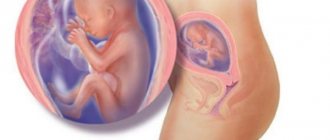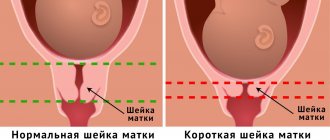How is CTE determined?
It’s worth saying right away: identifying the size of the fetus when determining CTE is an absolutely safe procedure and is part of the screening. Why is this necessary for a doctor:
- Determines the exact duration of pregnancy;
- Identifies possible developmental problems or, on the contrary, confirms that the embryo is developing normally;
- The indicators are compared with the weight of the fetus. This makes it possible to observe the future baby and predict the period of the baby's birthday.
It is carried out between 9 and 15 weeks of pregnancy. At a later time, the study of the coccygeal-parietal size (CPR) is uninformative.
Important! Experts recommend doing an ultrasound at 11 weeks, since it is during this period that the CTE result will be most reliable, and all pathologies are more easily identified at the 3rd month of gestation
Measuring the CTE of the fetus occurs using a conventional ultrasound sensor:
- The specialist “visually” divides the fetal body into two parts. The measurement begins from the head, that is, the crown and goes to the tailbone;
- The moment is selected when the child makes a minimum of movements. If this is not possible, then the moment of the maximum extended position of the body is recorded;
- Data is recorded in millimeters and checked against a table of acceptable standards
A woman should not move during the procedure for measuring the coccygeal-parietal size, and an hour before visiting the ultrasound room, it is better to give up sweet foods and drinks
What is KTR. How and when it is measured
The CTE of the fetus is the length of the distance in mm from the highest point of the unborn child’s head to the lowest point of its back. The indicator can be determined by ultrasound. Using this parameter, it is possible to accurately determine the duration of pregnancy at its early stage. CTG is such a universal characteristic that it absolutely does not depend on the individual characteristics of the development of the embryo and the gender of the unborn child.
The measurement is carried out using ultrasound: this is the safest method of examination during pregnancy, for both mother and child. CTE is determined, as a rule, at a period of 7-14 weeks (before the formation of the placenta), but it is most advisable to do the procedure at a period of 12-13 weeks.
It is at this time that the characteristic will be most informative, since with the onset of the 2nd trimester, fetal development is assessed by other indicators.
CTE directly depends on the duration of pregnancy, and the more weeks have passed since conception, the greater the value of this indicator. Gender and individual characteristics do not affect the coccygeal-parietal size in any way.
Here's what you need to know about CTE measurements:
- To obtain correct results, it is necessary to take measurements in such a projection that the child’s body can be divided into two identical parts.
- The indicator is recorded in the absence of fetal motor activity.
- If the child is too active at the time of the procedure, the doctor should take measurements at the moment of full straightening.
- The obtained figures are compared with data from the table, which shows the average statistical indicators of compliance standards by week of pregnancy.
Table of fetal CTE norms by week
As the gestational age increases, the CTE of the fetus gradually increases, which makes it possible to indirectly judge the normal course of pregnancy. Therefore, if a woman undergoes an ultrasound more than once in the first trimester, the doctor must evaluate the dynamics of changes in CTE. It is worth understanding that only a doctor can decipher the results and evaluate them. Because slight data deviations are completely normal. The child grows and develops every day, so add a few more days to more correctly determine the size of the fetus. The values of the coccygeal-parietal size by pregnancy are given in the table.
| Gestation period, weeks | Percentile values of CTE, mm | ||
| 5 | 50 | 95 | |
| 10 weeks | 24 | 31 | 38 |
| 10 weeks 1 day | 25 | 33 | 41 |
| 10 weeks 2 days | 26 | 34 | 42 |
| 10 weeks 3 days | 27 | 35 | 43 |
| 10 weeks 4 days | 29 | 37 | 45 |
| 10 weeks 5 days | 31 | 39 | 47 |
| 10 weeks 6 days | 33 | 41 | 49 |
| 11 weeks | 34 | 42 | 50 |
| 11 weeks 1 day | 35 | 43 | 51 |
| 11 weeks 2 days | 36 | 44 | 52 |
| 11 weeks 3 days | 37 | 45 | 54 |
| 11 weeks 4 days | 38 | 47 | 56 |
| 11 weeks 5 days | 39 | 48 | 57 |
| 11 weeks 6 days | 40 | 49 | 58 |
| 12 weeks | 42 | 51 | 59 |
| 12 weeks 1 day | 44 | 53 | 62 |
| 12 weeks 2 days | 45 | 55 | 65 |
| 12 weeks 3 days | 47 | 57 | 67 |
| 12 weeks 4 days | 49 | 59 | 69 |
| 12 weeks 5 days | 50 | 61 | 72 |
| 12 weeks 6 days | 51 | 62 | 73 |
| 13 weeks | 51 | 63 | 75 |
| 13 weeks 1 day | 53 | 65 | 77 |
| 13 weeks 2 days | 54 | 66 | 78 |
| 13 weeks 3 days | 56 | 68 | 80 |
| 13 weeks 4 days | 58 | 70 | 82 |
| 13 weeks 5 days | 59 | 72 | 85 |
| 13 weeks 6 days | 61 | 74 | 87 |
| 14 weeks | 63 | 76 | 89 |
The table shows the CTE values from 10 to 14 weeks, since it is during this period that ultrasound screening is carried out in the first trimester of pregnancy.
What is KTR?
The abbreviation KTR in expanded form is a fairly easy-to-understand combination of 3 words - coccygeal-parietal size, the meaning of which will be obvious even to a person far from the medical field. This term is used by doctors to refer to the length of the fetus during intrauterine development. The indicator is measured in millimeters.
CTE can with full confidence be called an additional method for assessing the gestational period. The result obtained as a result of this simple and painless procedure will serve as a kind of indicator of the progress of pregnancy. If, at the time of studying the relevant indicators, the baby lends itself to vigorous activity, it is worth giving preference to the measurements obtained with maximum extension of the body of the developing child: they will be closer to the truth.
Deviation from KTR norms
Additionally, if the measured CTE deviates slightly from the average values up or down, do not be alarmed. This only speaks about the characteristics of a particular fruit.
An increase in CTE for 1 or several weeks usually implies the further development of a large fetus (more than 4 kg). In such a situation, it is necessary not to abuse metabolic drugs (Actovegin, multivitamins), which can contribute to the development of a large and even gigantic (more than 5 kg) fetus. It is also necessary to exclude anatomical defects (neoplasms), diabetes mellitus in the mother, and Rh conflict, although this pathology usually manifests itself in the second and third trimester of pregnancy.
If the CTE is significantly less than normal
, then there are several options:
- Fertilization occurred later due to later ovulation
(the release of the egg from the follicle) and, accordingly, the gestational age is less than the period from the first day of the last menstruation, that is, this is a variant of the norm.
In this case, it is necessary to repeat the ultrasound in dynamics after 7-10 days
. - Non-developing pregnancy
in which the embryo/fetus dies.
It can be excluded by the presence of rhythmic fetal heartbeats of normal frequency (for the fetal heart rate norm, see the article “Ultrasound Norms by Week”) and its motor activity. A non-developing pregnancy requires urgent (emergency) assistance
- curettage of the uterine cavity to remove the fetus, as it can cause serious reproductive health problems (infertility) and even a threat to the woman’s life (bleeding, infectious-toxic conditions, including shock). - Hormonal deficiency
(most often progesterone deficiency) can lead to spontaneous abortion.
This condition requires additional examination for the quality of hormonal levels and hormonal support in case of its insufficiency (Duphaston, Utrozhestan - the dosage of the drug is selected only by a doctor!
). - Impaired fetal growth may be associated with an infectious factor
, which indicates the need to examine a woman for infections, including sexually transmitted infections, and their rational treatment within the permitted time frame. - Genetic disorders
(Down syndrome, Edwards syndrome, Patau syndrome) - require additional consultation with a geneticist, submission of genetic markers, and examination of the fetal chromosome set (karyotyping). For this purpose, together with ultrasound, it is carried out
biochemical screening
(determination of alphafetoprotein, hCG, PAPP-A, SP-1, protein S-100). If there is a deviation in ultrasound and biochemical parameters, the woman is offered:- amniocentesis
(puncture
of the amniotic
(amniotic) membrane with collection of amniotic fluid for further research), the optimal period for which is 16-20 weeks, - cordocentesis
(obtaining umbilical cord blood and studying it), - chorionic villus biopsy
.
important These examination methods make it possible to establish the exact chromosome composition of the fetus and its gender. However, it should be remembered that they are produced only with the informed consent of the pregnant woman, and every woman has the right to refuse them!
With serious genetic abnormalities, pregnancy usually ends spontaneously in the early stages. The occurrence of abnormalities in fetal development is facilitated by:
- Pathology of a woman’s internal organs
(heart disease, thyroid disease), although they usually cause problems in later stages of pregnancy. - Inferiority of the mucous membrane of the uterine cavity
after abortion, in the presence of uterine fibroids, which does not allow the fertilized egg to implant and grow normally, which often leads to spontaneous termination of pregnancy.
Thus, CTE is an important indicator that allows one to establish or clarify the gestational age, and its significant deviation from the norm should alert the doctor.
Interpretation of results
Normal KTE indicators at various periods are summarized in a table, which allows you to accurately determine both the gestational age and the correspondence of the size of the fetus to this period.
The analysis is based on taking into account deviations of average sizes (50th percentile) to a smaller (5th percentile) or larger (95th percentile) side. Extreme values (5th and 95th percentile) are also normal. They reflect the expected weight and size of the unborn child, but cannot indicate a deviation from the norm, a developmental disorder or pathology. CTE deviations during pregnancy below or above threshold values have clinical and prognostic significance.
The 11th week is of particular importance, since at this stage of fetal development it is possible to most clearly determine the presence of any anomalies or developmental defects in the unborn child. In the early stages, such data cannot be considered reliable, and in later stages, their ultrasound visualization may be difficult.
Since CTE during ultrasound changes daily, measuring this indicator over time is important. With normal development, it should correspond with certain minor fluctuations to the data indicated in the table. That is, if at the 8th or 9th week the CTE was close to the 95th percentile, then at the 11th week it should approximately correspond to this indicator. A slowdown or, conversely, unexpectedly rapid growth of the fetus may indicate a certain impact of some factors on the mother’s body, which led to inhibition or activation of development. This is not always a pathology. Only a doctor can evaluate the result, taking into account many clinical, social, environmental and other factors. The pregnant woman herself cannot correctly evaluate the CTE data, although they are in the public domain. The correct conclusions must be drawn by the obstetrician-gynecologist, who will make decisions on further tactics for managing the pregnant woman.
What to do in cases of deviation of the coccygeal-parietal size of the fetus?
As can be seen from the table above, the numerical norms of CTE are constantly growing. If the values go beyond normal limits, then this is not a reason to panic at all: it’s just possible that a heroic baby will be born, weighing more than 4 kg. But if a woman in labor has a narrow pelvis, then she faces a cesarean section. Therefore, a pregnant woman should:
- Watch your diet. Do not eat foods that are too high in calories. But don’t go on a strict diet either;
- Avoid taking multivitamins, as well as some medications, such as Actovegin and its analogues. They help increase embryo growth
Situations when the indicator is less than expected:
- Incorrectly determined obstetric period;
- Late ovulation;
- Problems with a woman's hormonal levels. This is usually progesterone deficiency;
- Infectious diseases;
- Frozen pregnancy;
If a decrease in progesterone levels is expected, the patient is tested to determine it in the body. If confirmed, Duphaston is prescribed 2-3 times a day and Utrozhestan vaginally. These medications can be used either in tandem or separately, depending on how low the hormone is in the pregnant woman.
Infection is another way to deviate CTE. This could be detected chlamydia, etc. The gynecologist takes a smear of the flora and determines the degree of purity. Based on its results, Hexicon and Pimafucin suppositories can be prescribed. Therapy is selected very carefully due to the interesting position of the woman.
A frozen pregnancy is confirmed by ultrasound. This diagnosis will be supported by the absence of a heartbeat in the fetus.
In addition, external factors also influence the growth or underdevelopment of KTP: poor nutrition, lack of microelements, overexertion.
How to decipher CTE data on ultrasound during pregnancy
As week after week passes, not only the duration of the pregnancy itself will increase, but also the CTE indicators. The size of the coccygeal-parietal zone of the fetus by week is considered to be the most accurate indicator at a fairly short stage of pregnancy. What can the obtained data tell us? In order to obtain a certain result, the CTE data must be compared with those indicators indicated by the obstetric period established by menstruation. If the specified deadlines in both options are too different, there are a number of reasons that cannot be ignored:
- The obstetric deadline was set with gross violations and was initially erroneous;
- The fetus froze at a certain week of development (this can be easily checked by the presence of a heartbeat);
- There is hormonal deficiency, which is a common cause of miscarriage;
- Deviations from normal growth, which indicates the presence of a viral disease or pathology;
- Presence of Down, Edwards, Patau syndromes;
- The degree of maturity of the placenta is higher than it should be at this stage and close attention must be paid to this fact.
All these points may be the reason for referral for additional examinations. Thanks to KTR, you can promptly identify the cause of such a difference in data and begin to eliminate it.
In addition, there is a table that indicates the number of weeks days weeks days, as well as indicators of the norm of fetal development.
Based on this table, one can judge whether the fetus is developing without deviations. If the level of CTE is below normal, then we can already talk about intrauterine growth retardation. In addition, by comparing the CTE and the degree of maturity of the placenta, it is possible to timely determine the moment at which its premature aging begins. Depending on how long it was detected, this moment can be considered a threat to the fetus or not.
Features of CTE at 12 weeks
12 weeks of pregnancy is an important stage for mother and baby. The mother’s symptoms of toxicosis begin to fade, and changes occur in the intrauterine life of the future person. The risks of miscarriage are reduced. Gynecologists recommend carrying out the first screening and measurement of CTE during this period, since the indicators will be the most accurate.
The normal value at 12 weeks is 51-52 mm. But the spread is large - from 43 to 60 mm.
From the next week of pregnancy, the size will increase to 64 mm. The future person has already formed many organs; he can intensively clench and unclench his fists. Even where the edges were, some fluff appeared. The thymus gland is developing, and hence the future immunity. The baby weighs 10-13 grams.
Thus, determining the coccygeal-parietal size of the fetus (CTE) is part of an important study that can prevent possible pathologies.
What is fetal CTE?
The coccygeal-parietal size, or abbreviated CTR, is an indicator of the size of the embryo, which is indicated in millimeters and is determined at various stages of pregnancy. Intrauterine measurement of the child is carried out during ultrasound examination, which is considered one of the safest ways to diagnose fetal development.
In the first trimester, the embryo has a curved shape, so you can measure the length of its body, taking into account the dimensions of the head and body. In this case, the determination is made between the points most distant from each other: from the top of the head to the lower back. Therefore, the indicator is called coccygeal-parietal.
Determination of CTE is carried out before the 12-13th week of pregnancy; later diagnosis using this indicator is less informative, since starting from the second trimester, doctors look at other sizes and parameters of the fetus, which are combined under the term “fetometry”.











